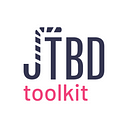Bring Focus To Your Efforts: JTBD For Product Managers
I’ve never worked for or with a company that didn’t have enough ideas. In fact, most are swimming in them — what the next feature or product offering should be, how to improve marketing and sales, and what company to buy or partner with should be. The list goes on and on.
But here’s a dirty little secret: ideas are overrated. Generating more and more of them rarely helps, and usually just makes things worse.
What’s needed instead is focus. Organizations need better logic and rationale for what to move forward and invest in. Sure, you can prioritize by cost or by technology or some other dimension. What’s really needed is to understand what’s most important to customers, and prioritize around that.
This is where JTBD comes in. It’s a holistic innovation framework to discover, define, and prioritize your best opportunities for success. That’s why it’s a great fit for Product Managers. It can help relativize backlog items and plan your roadmap ahead.
Previously we wrote about JTBD for Startups. It’s a perfect fit because with JTBD you don’t need to have a product to research — the job is the unit of analysis.
But many of you probably work in situations where there is an existing offering and have the desire to improve their products or services. JTBD can help here, too. Product managers, designers, and developers can use the lens of JTBD to find and prioritize areas of improvement for current solutions already on the market.
Below is a sequence of JTBD techniques you can use together to optimize an existing solution:
1. Conduct jobs interviews. Interview job performers to find out what they are trying to accomplish. Since there is an existing offering, you can recruit from your customer base but be careful to avoid talking about your solution during the interview. Instead, focus on the job and how they get it done.
2. Compare competing solutions. Distill needs statements from your interviews and compare how well competing solutions get the job done or not. Discuss the competitive landscape with your team and determine your sweet spot. Then take that insight into ideation sessions to come up with ways to get the job done better than others.
3. Create a consumption journey map. Diagram the current journey that customers have when interacting with your company. Look at the functional, emotional, and social jobs fulfilled along the way.
4. Write job stories. Once you narrow down actionable concepts to implement, create job stories to tie the JTBD research to product development and marketing campaigns.
5. Create a roadmap. Use the JTBD framework to guide your plan for improvements. Organize the roadmap around the core job themes you uncovered in your research.
For a concrete approach to road mapping, I recommend the book Product Roadmaps Relaunched by C. Todd Lombardo, Bruce McCarthy, Evan Ryan, and Michael Conners. JTBD plays a key role in aligning with customer needs, as the authors write:
“We recommend starting with the chunks of value you intend to deliver that will build up over time to accomplish your visions. Often this is a set of high-level customer needs, problems, or jobs to be done.”
Their approach breaks down the five key elements of a good product roadmap:
- Product vision: The vision outlines how your customers will benefit from your offering. How will the job performer benefit from the solution? What will getting the job done look like after the solution is in place?
- Timefames: Rather than committing to specific dates, good roadmaps sequence work and set broad timelines for completion.
- Themes: These are the key problems customers face when completing a job — their unmet needs you’re targeting.
- Business objectives: A roadmap must be aligned with the organization’s strategy and objectives. The goals of the business are important for measuring progress.
- Disclaimer: Roadmaps are subject to change.
The image below shows an example from their book of a basic roadmap overview for a fictional company, Wombat Garden Hose, illustrating these main components. It’s the “themes” that come right from JTBD analysis. What are the unmet needs the whole team is rallying around to fulfill for each period of time?
By anchoring JTBD in the roadmap, you’re ensuring that all of your efforts are aligned with customer needs.
One final note: as an alternative to jobs interviews, Switch interviews can also be used to find underlying problems to solve. In fact, you may find it easier to get started with Switch interviews when talking to existing customers. Be careful, however, not to focus only on the purchase decision-making process too much, and you’ll be OK.
Overall, JTBD provides a framework for moving from research to opportunity identification to roadmapping, helping product managers stay focused.
Learn more in our next mini-course (Dec 5, 7, 9) to learn how to go from insight to action with a complete JTBD project.
More resources at JTBDToolkit.com
